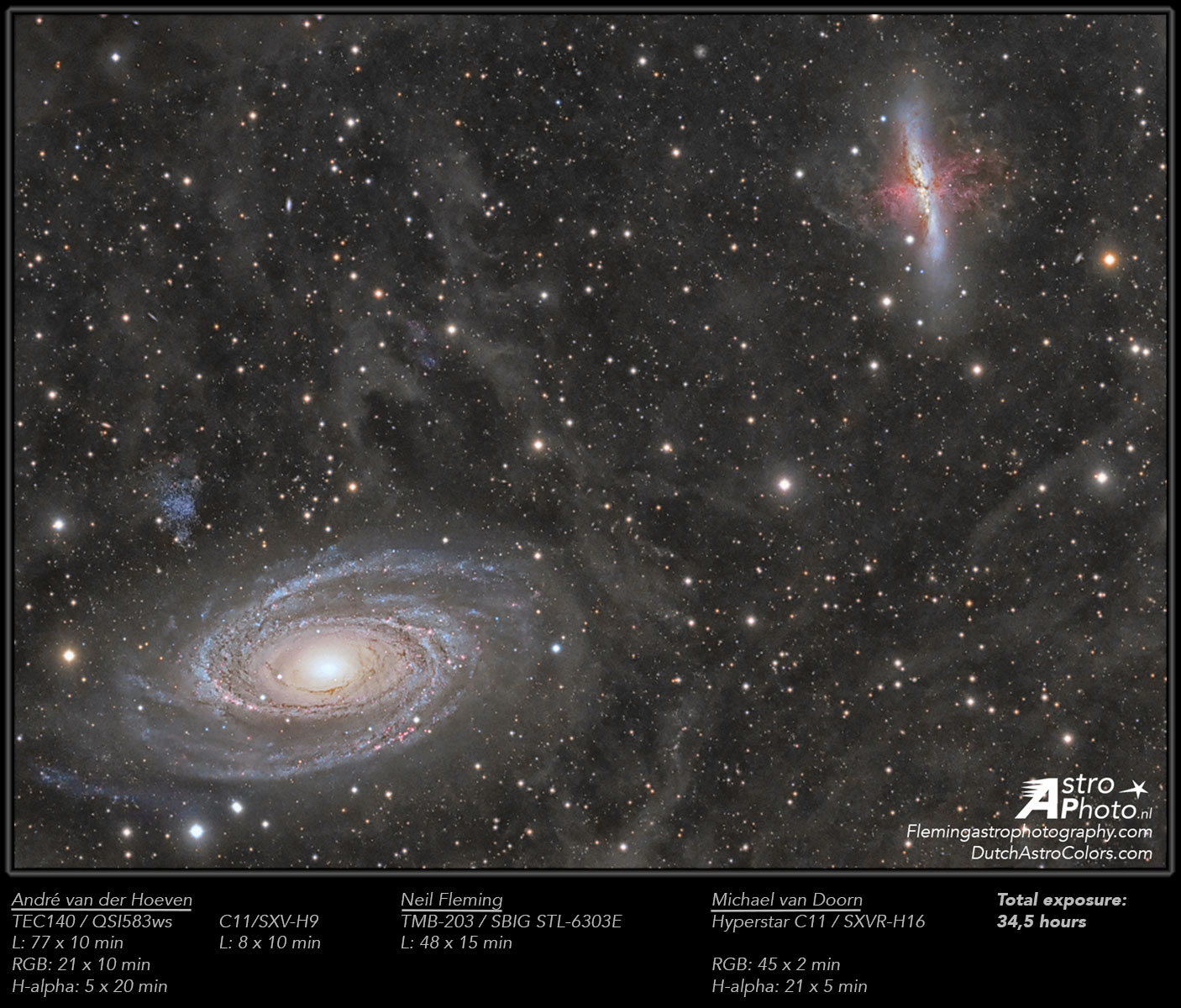 |
| M81 is the big spiral in the lower left. |
But there's also a potential "dark galaxy" here : a cloud of hydrogen that can't be seen at all at optical wavelengths but has its own dark mater halo, just like an optically bright galaxy. This was found back in 2001 with the HIJASS survey, which mapped (at least part of) the northern sky using the Jodrell Bank 76 m telescope. HIJASS and its more famous southern counterpart HIPASS had relatively low sensitivity and resolution by today's standards. This made it difficult for them to both find galaxies with low gas masses, where star formation is likely to be low, and identify the optical counterpart of any gas clouds they did find. With a resolution as low as HIJASS, you can usually find some sort of optical smudge that could be the optical counterpart, because you don't know exactly where the gas really is.
Despite this, they did find a handful of interesting dark galaxy candidates, one of which was near M81. Here the authors describe new observations with resolution that's more than 10x better and of comparable mass sensitivity to HIJASS. They also reprocess other observations from the VLA, GBT and Effelsberg telescopes. The main problem is that this group is at a very low redshift, so the HI emission from the galaxies occurs at similar frequencies to the Milky Way despite being ~3-4 Mpc away. They've developed a way to try and remove contamination from the Milky Way, though as far as I can tell this is basically just a fancy way of identifying which channels have contamination and removing them. I would have liked more figures to illustrate this though, as I get the impression it's more sophisticated than that and I don't fully understand what they've done.
Anyway, here's their main figure. The optical emission is in greyscale with HI contours in blue.
These new observations use an interferometer, which often miss emission on larger scales. So could these few clouds actually be embedded in a larger HI emission region ? Probably not : in this case, the total mass of the clouds is almost bang-on identical to the earlier data, so they've recovered all the flux.
Their interpretation is that this little patch of fluff is much more likely to be tidal debris than a dark galaxy, which I have to agree with. I suppose if you cut off the cloud on the left you could just about imagine that this is an edge-on disc, but it would be highly suspect, and in any case there's no evidence of rotation - the velocities of all parts of the cloud are similar. So although the line width is about 50 km/s (from the earlier observations), which would give a dynamical (i.e. dark matter mass) about 100x the HI mass given the size of the object, this is probably very misleading. It's much more likely to be tidal debris, which you'd expect to able to produce a few somewhat scattered clouds at similar velocities without much difficulty. The overall line width is low enough that this doesn't pose any great difficulties. In addition, the cloud - or clouds - are situated directly between IC 2457 and M81, which is exactly where you'd expect any tidal debris to be if they'd interacted. So we have, in effect, a means, motive and opportunity.
Unusually, the paper also includes a cool interactive figure. Here the connection between IC 2457 is a lot more obvious for some reason. To get the interactive version, open the paper with Acrobat Reader.
There are some caveats, but for once they're almost negligible. There's a remote chance that their Milky Way removal procedure has produced some sort of artifacts, but this seems unlikely. Slightly more problematically, it's not clear where the rest of the HI has gone (new readers should be aware that I've spent a great deal of time simulating this), but determining this would require detailed simulations - and the basic scenario of an isolated, denser patch of gas is consistent with previous modelling attempts of similar systems. What would be even more convincing would be more observations : either more sensitive HI data that could detect the expected stream of gas linking IC 2457 and M81, or other wavelengths such as Hα (which has been shown to be another pretty good tracer of interactions).
All in all, this is pretty persuasive that this dark galaxy candidate must be pronounced dead. Still, the authors are going to present a more detailed analysis in a future paper, which will probably be worth reading as the origin of the cloud could still be very interesting. In particular, at some point we're going to be reducing higher resolution data of our own dark galaxy candidates, so knowing what to expect if they're actually tidal debris is extremely useful.
A 5deg x 5deg deep HI survey of the M81 group
A 25 $\rm deg^2$ region, including the M81 complex (M81, M82, NGC 3077), NGC 2976 and IC2574, was mapped during ~3000 hours with the DRAO synthesis telescope.





No comments:
Post a Comment